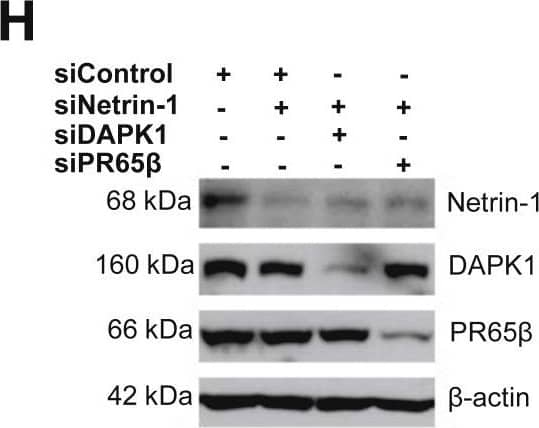Mouse Netrin-1 Antibody
R&D Systems, part of Bio-Techne | Catalog # MAB1109

Key Product Details
Validated by
Species Reactivity
Validated:
Cited:
Applications
Validated:
Cited:
Label
Antibody Source
Product Specifications
Immunogen
Val22-Ala603
Accession # AAC52971
Specificity
Clonality
Host
Isotype
Scientific Data Images for Mouse Netrin-1 Antibody
Detection of Human Netrin-1 by Western Blot
UNC5A and UNC5C induce caspase-3 activation through DAPK1/PR65b during UPR. (A) Quantification of netrin-1–receptor expression by qRT-PCR (mean + SEM, n = 3). (B–F) Identification of the implicated netrin-1 receptors. HepaRG cells were transfected with siRNAs and treated with DTT or not for 4 hours (mock). (B) Assessment of XBP1 mRNA splicing by RT-PCR. Representative result, n = 3. (C) Assessment of netrin-1 protein knockdown by immunoblotting. Representative result, n = 3. (D and E) Assessment of transcript knockdown efficiencies. Graphs indicate (D) UNC5A and (E) UNC5C mRNA levels in siRNA-treated cells in comparison with control siRNA-treated cells (mean + SEM; n = 3; Mann–Whitney test; P < .05). (F) Caspase-3 activation is reversed by UNC5A or UNC5C knockdown after UPR induction. Graph indicates caspase-3 activity ratio of DTT vs untreated cells for each condition (mean + SEM; n = 3; Mann–Whitney test; P < .05). (G–J) Identification of the downstream signaling pathway. HepaRG cells were transfected with siRNAs and treated with DTT or not for 4 hours (mock). (G) Assessment of XBP1 mRNA splicing by RT-PCR. Representative result, n = 3. (H) Evaluation of netrin-1, DAPK1, and PR65 beta depletion by immunoblotting. Representative result, n = 3. (I) Caspase-3 activation is reversed by DAPK1 or PR65 beta knockdown. Graph indicates the caspase-3 activity ratio for each condition (mean + SEM; n = 3; Mann–Whitney test; P < .05). (J) PP2A activity is increased by netrin-1 depletion and reversed by reduced expression of PR65 beta. Graph indicates PP2A activity ratio for each condition (mean + SEM; n = 3; Mann–Whitney test; P < .05). *,**, or *** refer to statistical analyses. Image collected and cropped by CiteAb from the following publication (https://pubmed.ncbi.nlm.nih.gov/28174720), licensed under a CC-BY license. Not internally tested by R&D Systems.Applications for Mouse Netrin-1 Antibody
Western Blot
Sample: Recombinant Mouse Netrin-1 (Catalog # 1109-N1)
Reviewed Applications
Read 1 review rated 5 using MAB1109 in the following applications:
Formulation, Preparation, and Storage
Purification
Reconstitution
Formulation
Shipping
Stability & Storage
- 12 months from date of receipt, -20 to -70 °C as supplied.
- 1 month, 2 to 8 °C under sterile conditions after reconstitution.
- 6 months, -20 to -70 °C under sterile conditions after reconstitution.
Background: Netrin-1
Mouse Netrin-1 is a member of the laminin-related family of axon-guidance molecules, collectively referred to as Netrins (netr is Sanskrit for “one who guides”). The molecule’s cDNA encodes a 603 amino acid (aa) protein precursor that has structural similarity to the N-terminal gamma-chain of laminin. It contains a globular domain, three EGF repeats, and a C-terminal heparin-binding domain. Mouse Netrin-1 shares 52% aa identity with mouse Netrin-3, and 98% and 87% aa identity with human and chicken Netrin-1, respectively. Cells reported to express Netrin-1 in the embryo include cells of the floor plate, ventricular zone of the spinal cord, the brain, the ganglionic eminence, and parts of the diencephalon. Netrins were first identified for promoting the outgrowth of commissural axons and are also involved in helping migrating cells and axonal growth cones navigate to their targets. Netrins can provide both attractive and repulsive cues to neurons, depending on the receptors present and cellular context. In the adult, Netrin-1 is likely involved in axon regeneration in peripheral nerves. Netrin‑1 has also been shown to be expressed outside of the nervous system and to be involved in development of such tissues as the pancreas, lung, bowel, bone and mammary gland. In non-neural organogenesis,
Netrin‑1 provides an adhesive rather than guidance function. The DCC (deleted in colorectal carcinoma), Neogenin, the UNC5 family of receptors, and the adenosine A2b receptors are proposed to be functional receptors for Netrin-1 (1-7).
References
- Puschel, A. (1999) Mech. Dev. 83:65.
- Hedgecock, E. and C. Norris (1997) Trends Genet. 13:251.
- Kappler, J. et al. (2000) Biochem. Biophys. Res. Commun. 271:287.
- Madison, R. et al. (2000) Exp. Neurology 161:563.
- Srinivasan, K. et al. (2003) Dev. Cell 4:371.
- Livesey, F.J. (1999) Cell Mol. Life Sci. 56:62.
- Corset, V. et al. (2000) Nature 407:747.
Alternate Names
Gene Symbol
UniProt
Additional Netrin-1 Products
Product Documents for Mouse Netrin-1 Antibody
Product Specific Notices for Mouse Netrin-1 Antibody
For research use only
